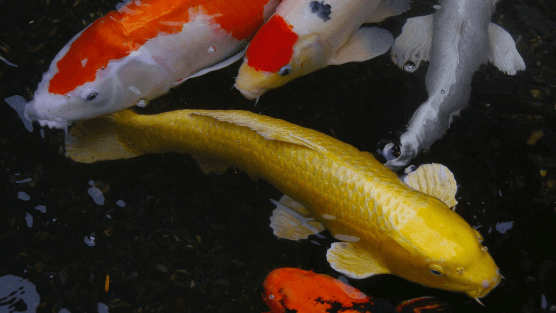Best Pond Fish Varieties For East Tennessee
It’s Spring and We have fish back in stock! One of the questions We get often is, “Which type pond fish should I get?”. We carry two basic types of fish, Koi and Comets. Both of these varieties of fish will live peacefully together. The only exception to this is that Koi as they get larger may eat baby fish if they do not have habitat to hide in.
How many fish can I have in my pond? The general rule of thumb is 1″ of fish per 10 gallons of water. When figuring this out, take into consideration the size the fish will get, not how big they are when you buy them. If you have good filtration, you can sometimes exceed this amount without problems.
Koi
Koi are a decorative form of Carp that are bred for color, scale types, and scale patterns. We carry two types of Koi, Standard and Butterfly.
- Standard Koi – They are generally torpedo shaped, with scalloped fins and whiskers. In small to medium ponds they usually grow to 12″ – 18″ long. In large ponds they can reach up to 36″ if the conditions are right.
- Butterfly Koi – Have the same torpedo shape and whiskers, but the tail, dorsal and pectoral fins are long and flowing. They can reach the same size as standard Koi.
Comets
Comets are “gold fish”, which was also a Carp originally. We carry two varieties of Comets, Sarasa and Shubunkin.
- Sarasa Comets – are distinguished by a orange/red body with white patches and a single tail. They can reach 8″ – 12″ in length, sometimes a little larger.
- Shubunkins – have a distinctive calico pattern of alternating white, black, blue and orange, and a single tail. They are the same size as Sarasa, but can have longer more flowing tails.
Introducing Fish To A Pond
After choosing the type of fish and purchasing them, the next step is introducing them into your pond. You want to get the temperature equalized between your pond and the water in the bag. You want to avoid putting fish used to one temperature into an environment that is greatly different (either warmer or colder). This can be accomplished in two ways, floating the bag or gradually adding pond water into the bag. Don’t dump the entire bag into your pond! Fish are constantly going to the bathroom. By the time you get them home, the water in the bag will have ammonia and nitrates in it that you don’t want to add to your pond.
Take a look at this blog on Aeration!

